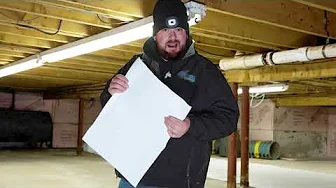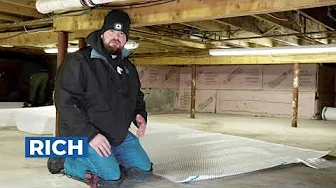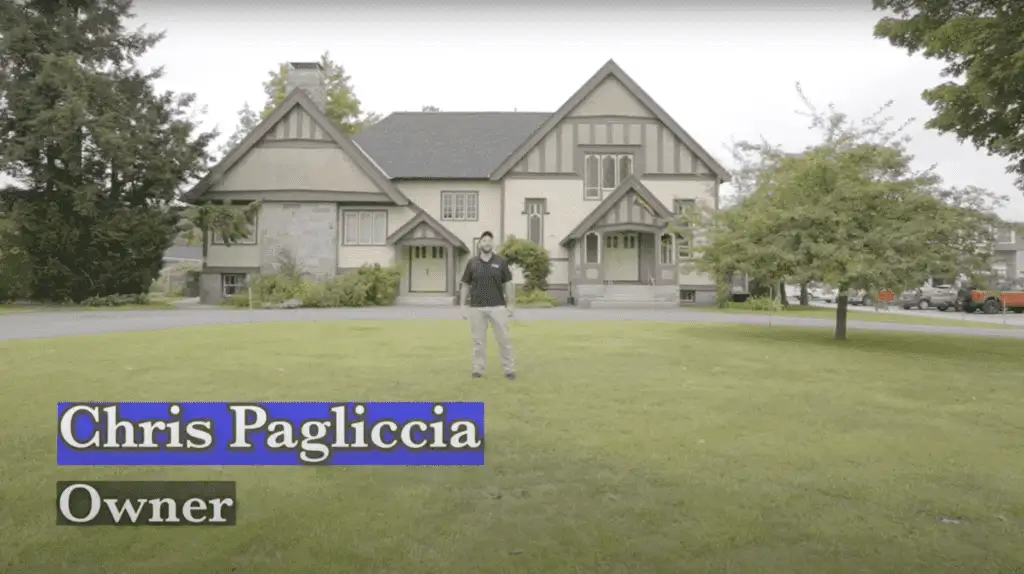Basement Finishing Hampton NH
Basements are often overlooked when it comes to home improvement. They’re seen as storage areas or forgotten spaces. But these underground rooms hold incredible potential. Turning a basement into a finished space can add value to your home, create more usable square footage, and expand your living options.
For homeowners in Hampton, NH, basement finishing can be especially appealing. With the right approach, you can transform your basement into a functional, comfortable, and beautiful part of your home.
Real People - Real Great Results
Crawl Space Video Playlist
Benefits of Basement Finishing
When it comes to finishing your basement, the benefits are undeniable. It’s not just about slapping up drywall and calling it a day—it’s a move that can transform your home’s functionality and future resale value. Here are the key reasons why basement finishing is worth the effort, especially for homeowners in Hampton, NH:
- Increase Usable Space: Let’s face it, your basement is probably underperforming. You’ve got square footage just sitting there, begging for a purpose. Turning it into a livable space—be it a cozy den, guest room, or home gym—instantly expands how much of your home you can actually use. What’s more, it’s a lot cheaper than building onto your house with a new addition. Think of it as stealth expansion.
- Boost Home Value: Finished basements don’t just hand you extra space; they hand you leverage when it’s time to sell. Prospective buyers love the idea of walking into a home and seeing a polished, multi-purpose lower level. It’s not just a selling point—it’s a top-dollar selling point. The return on investment is strong, making basement finishing both a practical and financial win.
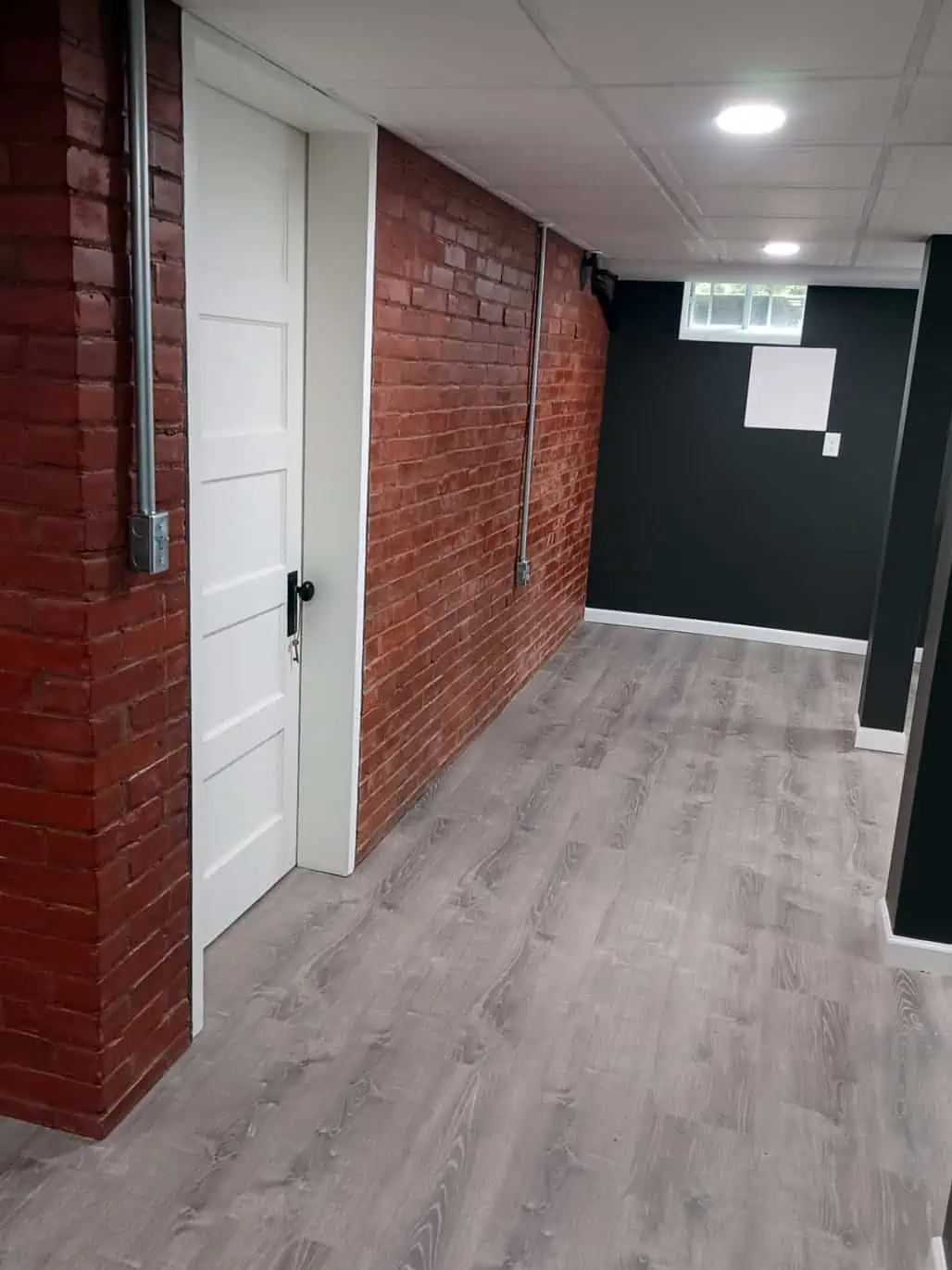
- Improve Energy Efficiency: Basements are usually drafty, cold, and about as inviting as a walk-in freezer. Finishing them not only adds some polish but also takes care of insulation gaps and regulates temperature fluctuation. Think sealed walls, proper insulation, and maybe even upgraded HVAC work—your heating and cooling bills will breathe a sigh of relief, especially in Hampton’s bone-chilling winters.
- Solve Existing Issues: Here’s the reality: your unfinished basement is probably a walking (or leaking) liability. From moisture problems to bystander cracks in the foundation, taking on a basement finishing project forces you to tackle these issues head-on. Sure, it’s not as glamorous as picking paint colors, but addressing structural and moisture concerns during the renovation process protects the entire home. And no one complains about sidestepping mold.
- Create a Custom Space: Maybe you’re craving a swanky bar setup or a quiet corner for your Peloton. Or perhaps your dream involves an in-law suite that ensures family visits come with maximum comfort and privacy. The beauty of finishing a basement is the ability to mold the space to your life. It’s one home project where you don’t have to compromise.
In short, finishing a basement is about more than just aesthetics or filling an empty space. It’s about unlocking potential—in your home, your budget, and even your daily life. Those bare concrete walls and low-hanging pipes? With the right plan, they’re just waiting to work harder for you.
Essential Considerations for Basement Finishing in Hampton, NH
Transforming your basement into a usable, finished space isn’t just about slapping on some drywall and picking out furniture. It requires thoughtful planning and an understanding of the unique challenges basements bring—especially in a coastal New England town like Hampton, NH, where weather and building regulations can play a significant role in your project’s success. Let’s break down the fundamentals.
1. Address Moisture and Waterproofing
Hampton’s proximity to the coastline increases the likelihood of moisture issues in basements. If you skip this step, you’re setting yourself up for headaches down the line, and by headaches, I mean mold, mildew, and structural damage. Fun, right? Any finishing effort should begin with a deep dive into waterproofing. This might mean adding a sump pump, sealing foundation cracks, or installing a vapor barrier to keep water out.
Whatever you do, don’t assume that waterproof paint alone will cut it. This is your foundation we’re talking about—treat it like the MVP it is. And don’t rely on your gut to gauge the problem’s severity. A professional assessment will save you from playing a guessing game—not to mention a potential DIY catastrophe.
2. Adhere to Local Building Codes
Here’s where things get spartan and very unsexy: compliance. Hampton, NH, like any responsible municipality, has strict building codes, and ignoring them isn’t just careless—it’s expensive. Want to add a bathroom? You’ll need permits for plumbing. Making a cozy guest suite? Your plans must include an egress window or another emergency exit.
You also can’t skimp on fireproofing requirements, especially when using wood or certain types of insulation. If you’re zoned in a flood-prone area, you may also face additional compliance barriers. It might feel like red tape overload, but trust me, these rules exist for your safety and to protect the value of your home.
3. Choose the Right Layout
If your vision is “open and airy,” the average basement might have other plans. Low ceilings and limited natural light can make the space feel cramped—unless you design smart. Keep traffic flow and functionality top-of-mind. For example, arrange larger amenities (like a couch or gym equipment) along walls, leaving the center open for movement.
Ceiling height is another hurdle. If your basement feels like a hobbit cave, consider options like shallow recessed lights or even slightly lowering the floor—a big project, yes, but sometimes essential. The layout should also account for existing support beams, plumbing, and electrical wiring. Don’t fight these features; work them into your design so you’re not racing against physics.
4. Insulate Properly
New England winters don’t mess around, and neither should you. Installing quality insulation isn’t just about keeping the space cozy—it also protects against moisture and keeps energy costs in check. Foam boards and spray foam tend to hold up better against damp conditions compared to traditional fiberglass.
The key here is to think of your basement as a blank canvas—not a dungeon with a rug. Insulation ensures the space feels like part of the home, not an afterthought someone slapped together with duct tape on a weekend.
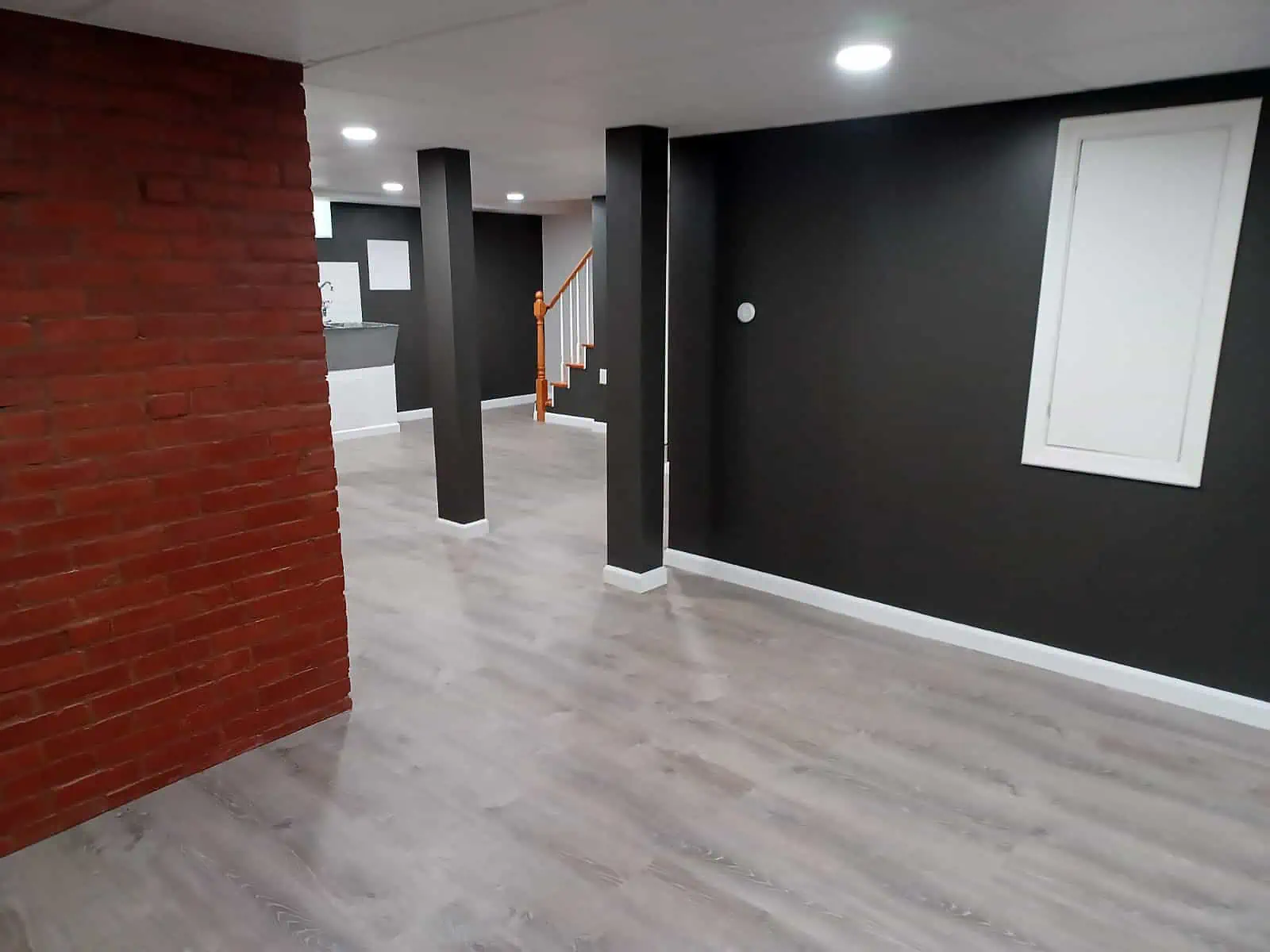
Popular Uses for Finished Basements
- Home Office or Workspace: Let’s face it—working from your kitchen table gets old fast. A finished basement can be the perfect solution, offering a quiet, designated space where you can focus without the constant hum of household activity. Think ergonomic setups, plenty of outlets, and maybe even built-in shelving for that added “I mean business” vibe.
- Extra Living Area: Need a place for guests to stay? Or maybe just a teenager-proof hangout zone? A finished basement ticks both boxes. With a comfortable sofa bed (or an actual bed, if you’re splurging), decent lighting, and a touch of homey decor, you can turn that underground space into a cozy retreat for family or visitors. Bonus: it’s far enough from the main living area that everyone gets a bit of personal space.
- Entertainment Zone: Basements were practically born to be entertainment hubs. Whether it’s a full-blown home theater, complete with reclining chairs and surround sound, or a more casual game room setup with a pool table and dartboard, your options here are endless. Add a mini-fridge or snack bar, and you’ve got a space people will never want to leave—which may or may not be a good thing, depending on how much you enjoy hosting.
- Fitness Area: Why drag yourself to the gym in the middle of a New Hampshire winter when your basement could be your workout haven? A finished basement can accommodate all your fitness needs, from free weights and yoga mats to a treadmill or stationary bike. Invest in durable rubber flooring and a good ventilation system to keep things fresh and functional. No excuses when “the gym” is one flight of stairs away!
Material Choices for Basement Finishing
1. Flooring
The wrong flooring choice can make or break your finished basement. Rule number one: avoid anything that can’t handle moisture. Basements, by their very nature, are more humid and prone to dampness than other parts of the house. That means carpet or traditional hardwood is asking for trouble. Instead, aim for materials that combine durability with water resistance.
Luxury vinyl planks are a top contender—they’re tough, stylish, and mimic the look of hardwood without the risk of swelling or warping. Tile is another solid option, particularly in areas that might see more foot traffic or spills. And for those wanting a modern, low-fuss vibe, sealed concrete can offer an industrial-chic aesthetic while being practically indestructible. If you’re craving a bit of warmth without committing to wall-to-wall carpet, layer in a couple of area rugs. They add coziness but can be pulled up and cleaned easily if the unexpected ever happens.
2. Walls
Basement walls can be tricky, given the constant battle against moisture. Play it safe with materials specifically designed for damp environments. Moisture-resistant drywall (often called green board) is a popular choice—it looks like standard drywall but adds some extra defense against mold and mildew. For an even more robust setup, insulated wall panels can provide both protection and an added layer of insulation.
Whatever you pick, steer clear of wood paneling unless the space is bone dry year-round. While it might give off retro vibes, wood doesn’t play nicely in humid conditions—you’ll risk warping, swelling, and potentially mold.
3. Ceiling
Ceilings in basements can be tricky, especially if you’ve got plumbing or electrical systems running overhead. Drop ceilings, while not the most glamorous, can be a lifesaver when you need easy access to utilities. Plus, newer designs have come a long way, offering more modern-looking tiles that avoid the office-ceiling stereotype.
If you’re not worried about accessibility and want to maximize ceiling height, an open-look can work wonders. Paint the exposed beams and pipes a deep, uniform color like black or dark gray for an industrial aesthetic that feels intentional, not unfinished.
4. Lighting
Basements are chronically lacking in sunlight, so lighting is your secret weapon in ensuring the space feels inviting. Start with LED recessed lighting for an unobtrusive option that floods the room with brightness. LEDs not only keep the space well-lit but also stay cool—important in tighter spaces where heat build-up could make things uncomfortable.
Layer it up. Don’t just stop at ceiling lights: throw in some floor lamps or sconces to create pockets of warmth. Accent lighting—like fixtures that highlight specific areas or design features—can add personality and ensure everything feels less like a basement and more like a cozy retreat.
Steps To Finish Your Basement
Turning a raw basement into a fully finished space can feel daunting, but breaking it down into clear, manageable steps makes the process not only achievable but downright rewarding. If you’re in Hampton, NH, here’s how to get it done—straightforward, no fluff.
- Plan Your Design: First things first: figure out what you want from this space. Do you need a guest suite? A home theater? A gym? A killer layout starts with a purpose. Sketch out your ideas or use design software to visualize the space. This isn’t the time for guesswork. Think about where your walls, outlets, lighting, and plumbing fixtures will live. That one outlet in just the wrong place will drive you nuts later.
- Get Necessary Permits: Hampton’s not the place to cut corners with permits. Building codes are strict for a reason, especially when it comes to basements that often double as safety challenges (did someone say “egress windows”?). Hit up local authorities, get the paperwork sorted, and avoid the nightmare of undoing work down the line. Permits might feel like a hassle, but trust us—they’re less painful than fines.

- Address Structural and Waterproofing Needs: You know what’s worse than a dark, unfinished basement? A finished one with water damage. Start by sealing cracks, waterproofing walls, and installing systems like sump pumps if needed. Waterproofing isn’t optional—it’s your armor against mold and expensive fixes in the future. If you’ve got moisture issues and try to skip this step, you’re inviting a disaster that doesn’t RSVP.
- Frame, Insulate, and Install Drywall: Now it’s time to bring your layout to life. Frame out the walls, adding studs to carve out rooms or define open spaces like a pro. Insulation is your best friend here, especially when New Hampshire’s winters roll in. Make it airtight with spray foam or rigid foam boards, then finish it off with drywall. Done right, this step transforms the space from “basement” to “actual room.”
- Complete Electrical and Plumbing Work: Bring in a licensed pro if you’re not trained for electrical or plumbing. This is no time to channel your inner DIY warrior unless you’ve got the credentials. You’ll need outlets for lighting, your entertainment zone, and whatever gadgets your space demands. Plumbing? It better be solid, especially if you’re installing a bathroom or wet bar. Sloppy work here doesn’t just ruin aesthetics—it can ruin the whole project.
- Install Flooring and Finishes: Flooring is the final building block of your basement’s personality, so choose wisely. Vinyl planks, tile, or even polished concrete are safe bets against moisture. Once that’s in, it’s all about the details: paint, trim, ceiling finishes, and doors. This is where you make the space yours. Sleek and minimalist? Cozy and warm? Your call. Either way, this is the moment it stops looking like a project and starts feeling like home.
By sticking to these essentials, you’ll turn your basement into something you actually want to spend time in—no unnecessary extras, no shortcuts, just a smart, clean execution.
Common Challenges With Basement Finishing
Basement finishing isn’t always a smooth ride. While the potential rewards are undeniable, the process often comes with its fair share of hurdles. Being prepared for these challenges—and knowing how to tackle them—can save you time, money, and a lot of frustration.
- Moisture Problems: Water is public enemy number one when it comes to basements. Poor waterproofing can turn your dream project into a damp, musty headache. From minor condensation issues to full-blown leaks, moisture problems can lead to mold, structural damage, and ruined materials. Preventive measures, like sealing cracks, installing a sump pump, or adding vapor barriers, are non-negotiable. If you start skimping here, you’re only inviting costly issues down the road.
- Low Ceilings: Basements in older homes, in particular, tend to have lower ceilings, which can make the space feel cramped. Ripping out what’s not load-bearing can help, but sometimes you have to work with what you’ve got. Using recessed lighting instead of fixtures that hang down, opting for lighter paint colors, or even exposing ceiling beams for an industrial vibe can create the illusion of height. It won’t change the physics, but it will change the perception.
- Ventilation: Most basements weren’t designed with airflow in mind. The air can feel stagnant, or worse, smell like yesterday’s laundry. To fix this, you need proper ventilation. Consider installing an HVAC system extension or a standalone dehumidifier to keep the air fresh and the humidity low. Without it, you might end up with a finished basement that no one actually wants to spend time in.
- Code Compliance: Basement projects often run afoul of local building codes, especially when homeowners rush the process. In Hampton, NH, emergency egress windows might be required if you’re adding a bedroom, and proper fireproofing can’t be skipped. Failing to adhere to these regulations doesn’t just stall your project; it puts your family at risk and could result in fines or legal headaches.
- Lighting Constraints: Basements aren’t generous with natural light, and that reality can make the space feel closed in. Relying solely on overhead lighting can create a harsh, sterile vibe. Instead, layer your lighting strategy: recessed ceiling lights for general illumination, wall sconces for ambiance, and floor lamps for softer accents. It’s about making the underground feel a little less… underground.
Basement finishing can be a game-changing upgrade for your home, but don’t underestimate the challenges lurking beneath the surface. With careful planning—and a good dose of stubborn persistence—you can dodge these pitfalls and end up with a functional, inviting space that defies the stereotype of dark and dingy basements.
Conclusion
Basement finishing in Hampton, NH can transform an underutilized, often forgotten area into one of the most functional and valuable parts of your home. This isn’t just about adding square footage—it’s about unlocking potential. A well-finished basement can be anything: a quiet home office, a cozy entertainment zone, a practical guest suite, or even a dedicated gym.
But here’s the catch: success lies in the details. You can’t wing it. Address moisture issues upfront—not after the fact. Stick to Hampton’s local building codes, no matter how tempting it is to cut corners. Think about the space you’re creating long-term, not just for the first coat of paint. A thoughtful layout and the proper choice of materials will ensure your basement isn’t just functional, but also comfortable and durable.
Done right, a finished basement isn’t just a room—it’s an upgrade, a value-booster, and an answer to your home’s evolving needs. Treat it as the blank slate that it is, and you might just end up with the most versatile space in your entire house.
Reviews from Happy Customers
Our top priority is customer satisfaction, and we work closely with clients to understand their unique needs and goals.




